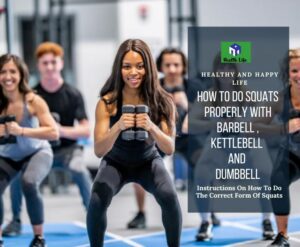We are ecstatic to announce that the squat bandwagon has finally arrived, and it won’t be going anywhere anytime soon. This effective motion must to be added to your workout routine as soon as possible if it isn’t already. In addition, we have the statistics to proof our claim. In this article is going to find out, how to do squats properly with 10 vatiations including barbell, dumbbell and medicine ball etc…
The squat has been hailed as a “excellent exercise to strengthen the entire lower limb for both athletics and ADLs (activities of daily life)” and has been shown to have benefits for both performance and appearance.
You want to jump higher, don’t you? Squat. Develop your abdominal muscles more. Squat. Could you put a little more fabric in the seat of your jeans? Squat.
Continue reading for a full instruction on how to squat with the correct form if you are unfamiliar with the exercise but are ready to give it a try.
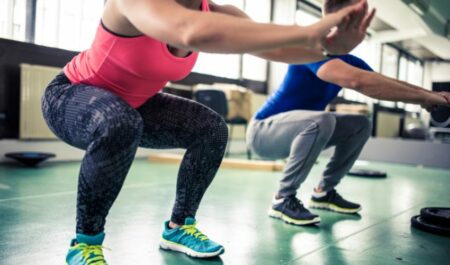
You Might Want To Begin With Some Squat Therapy
In order to try out this sequence, finish two sets of five repetitions each.
It is crucial that you have excellent form in a bodyweight squat before moving on to weighted squats because weighted squats are wonderful for gaining strength.
Because the mechanics of a squat are more complicated than they may at first appear, it is essential to make sure that all of the joints and muscles are moving in the correct manner in order to minimize the risk of injury and maximize the benefits of the exercise.
Squat therapy is an excellent method for achieving this goal. This mix of drills, which are used to help break down all of the small movements involved in a squat, should help you feel more comfortable moving around.
Wall Squat.
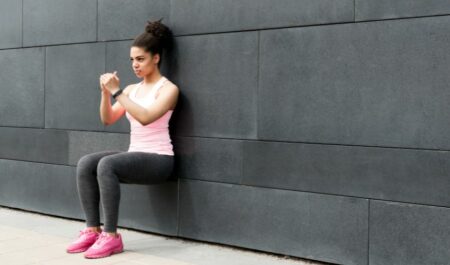
When you squat, your butt should touch the edge of the surface you’re sitting on, so position a bench or low chair approximately three feet away from the wall. Position yourself so that your back is against the wall and your feet are hip- to shoulder-width apart.
While keeping your chest lifted and your core braced, sit back into your hips and bend your knees. It should take you about 5 seconds to squat down until either your butt reaches the bench or your face gets too close to the wall. To get back to the starting position, quickly press through your full foot.
When you find that you can do this with ease, stretch your arms above your head and continue the action.
Continue to improve your flexibility and range of motion by moving the bench closer to the wall as it becomes easier for you to do the previous exercise.
Goblet Squat.
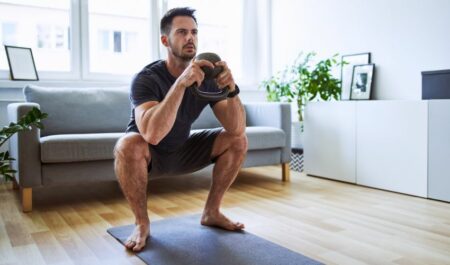
You should be able to comfortably hold a light plate or dumbbell by its sides at chest level, with your elbows pointed outward and downward. Maintain a shoulder- to hip-width distance between your feet when you stand.
Start by sitting your hips back and bending your knees as you perform a squat. When you lower yourself into a deep squat, you should bring your elbows in toward your knees and drive them outward.
Try to get a little bit lower after taking a few deep breaths, then holding this position for a few more seconds. After you have done this three to four times, stand back up.
Squat Using Only Your Own Bodyweight.
Before moving on to heavier weights, you should have no trouble completing three sets of 15 repetitions.
A fundamental move that should always be included is the bodyweight squat. The majority of the work will be done by your quadriceps, glutes, and hamstrings, while your core will be responsible for stabilizing you throughout.
How To Get Moving:
- You should stand with your feet about shoulder-width apart and your arms by your sides in a straight down position.
- You should brace your core and maintain a proud chest while you begin to push your hips back and bend your knees as though you are going to sit down. Make sure that there is no giving way in your knees. At the point where your thighs are parallel to the floor, take a brief break.
- To return to the beginning position, apply even pressure throughout your entire foot and push up.
Squats Using Only Your Own Bodyweight Are Another Option.
You should begin by completing two sets of 10 repetitions, and then work your way up to performing three sets.
When compared to a standard bodyweight squat, more advanced variations of the exercise, such as the deep squat and the one-legged squat, call for a greater degree of mobility and flexibility.
Deep Squat.
A deep squat is one in which your thighs move past the parallel position. This is sometimes endearingly referred to as the “ATG” (a** to grass) squat.
To perform a deep squat, you will require a good deal of flexibility, and if you add a lot of extra weight, the risk of injury will increase significantly.
How To Get Moving:
Squat down using only your own bodyweight. Instead of stopping when your thighs reach parallel, continue squatting down until the crease in your hip falls below your knee. Your bottom should be virtually touching the ground at this point.
Return to the beginning of the exercise, ensuring that your body remains straight and that you push through your full foot.
One-Legged Squat.
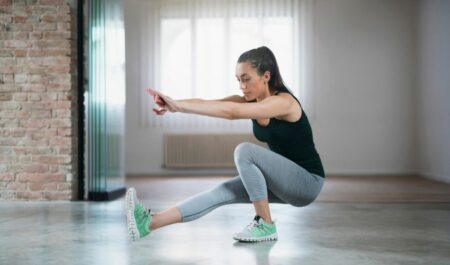
Squatting on one leg, also known as a pistol squat, is an advanced form of a squat that has a lot of benefits and may be done in a variety of ways.
To perform a one-legged squat well, you will require a significant amount of flexibility as well as strength, which is more than you will need for a standard bodyweight squat. However, it’s possible to begin at a high level and gradually work your way down as you improve.
How To Get Moving:
- You should be standing next to the surface you can rely on for support, and you should lift the outside foot off the ground while bending your knee at a 90-degree angle. Raise the outside of your hip.
- Squat down on your inside leg while preventing your inside knee from caving in. Start by putting your weight on your inside leg. Make an effort to get parallel, making use of the stable surface if necessary.
- When you have descended as far as you possibly can, you should then push yourself up up through your full foot and go back to the beginning.
- After completing the required number of repetitions, switch legs and repeat.
Barbell Squats.
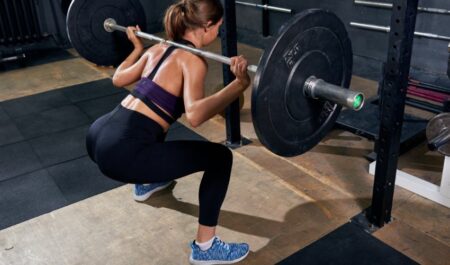
You should begin with two sets of ten to twelve repetitions for each of these exercises.
Squats performed with added weight from a barbell will not only help you build strength in your lower body and core, but will also provide a workout for your upper body.
When performing squats, it is recommended to do so inside of a rack or cage so that you may safely load the barbell and “fail out” when necessary if you are unable to complete a repetition.
Back Squat.
When most people think of a weighted squat, the image that pops into their heads is that of a back squat. The standard squat using only one’s own bodyweight serves as an excellent foundation for this move, which serves as an excellent progression.
In addition to increasing your power, you’ll see improvements in the strength of your quadriceps, glutes, and hamstrings.
How To Get Moving:
- Be sure to load the barbell onto your shoulders and traps in a secure manner. You should be standing with your feet slightly wider than shoulder-width apart, toes turned out slightly, your core braced, and your chest lifted.
- Start with a basic squat position with your hips back and knees bent, being sure that your knees do not cave in. When your thighs are approximately parallel to the ground, pause the exercise.
- To get back to the beginning, you need to press through your entire foot.
Front Squat.
The front squat places more of the pressure on the quadriceps than the traditional back squat since it places the weight on the front of the body. In order to perform the front squat, you will also require a lighter barbell.
How To Get Moving:
- The barbell should be positioned so that it is resting on the front aspect of your shoulders. When your arms are extended in front of you in a straight line, the barbell shouldn’t move. Once more, your feet should be spaced shoulder-width apart, your toes should be turned out slightly, your core should be braced, and your chest should be lifted.
- You should start to sit back with your hips while bending your knees and you should stop when your thighs are parallel to the ground.
- To get back to the beginning, you need to press through your entire foot.
Why Barbell Squat Performances Are Fail?
Utilize the rack or cage to your advantage if the weight becomes too heavy for you to squat and you are unable to complete the repetition.
In order to successfully complete this movement, you will need to stoop down further than you would ordinarily, enabling the rack or cage to grab the barbell, and then coming up from underneath it.
You also have the choice to perform your barbell squat reps with the assistance of a spotter. If you are unable to complete the repetition, this person will stand behind you and assist you in lifting the weight back up.
If you are working out by yourself and find that you are unable to complete a set, your objective will be to move the barbell off your back while simultaneously moving your body swiftly forward out of the way.
Different Kinds Of Weighted Squats.
You should begin with two sets of ten to twelve repetitions for each of these exercises.
Squats performed with dumbbells, medicine balls, or on machines all contribute to a significant increase in one’s overall strength.
Dumbbell Squat.
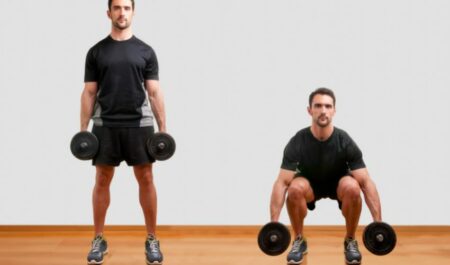
Aside from providing a good workout for your upper body, holding dumbbells down at your sides allows for a new motion pattern to be performed.
How To Get Moving:
- Keep your arms at your sides and hold a dumbbell in each hand while doing this exercise. Maintain a shoulder-width distance between your feet while also pointing the tips of your toes slightly outward.
- Perform a basic squat while letting the weights dangle down at your sides while you do so.
Squats With A Medicine Ball Performed Overhead.
Because the overhead squat needs a significant amount of flexibility in the hips, shoulders, and thoracic spine, you should begin with a light weight and gradually increase it as you become more proficient in the technique.
How To Get Moving:
- Maintain a stance with your feet slightly wider than shoulder-width apart and a medicine ball held above your head.
- Squat down while keeping the medicine ball in the overhead position; of course, the movement should begin in the hips, and the goal should be to retain the medicine ball in an upright position as much as possible.
Hack Squat.
You can perform a hack squat with a barbell, but the hack squat machine is a better option for novices. If you want to try this exercise, get to the gym!
How To Get Moving:
- Step up onto the machine, keeping your back on the support and your knees as close to straight as possible.
- Your feet should be roughly shoulder-width apart, your shoulders should be resting just underneath the pads, your elbows should be bent, and your hands should be clutching the handles. Position yourself so that you can perform the exercise effectively.
- Put the weight down and squat down while maintaining a straight back, a bent knee position, and your head, neck, and upper back flush against the machine.
- Fight the need to give up at the knees, and as your thighs approach parallel, push yourself back up to the starting position.
Watch Out For These Common Mistakes.
The following are some of the most frequent errors made while squatting:
- The give way in the knees. Make sure that your knees are always falling out.
- Not leading with your hips as the primary focus. When performing a squat, the movement should be started from the hips, not the knees.
- letting your knees come over your toes while you perform the pose. This can be avoided by sitting with your hips further back.
- Your failure to engage your core. This movement cannot exist without a solid core to support it.
- letting your chest collapse forward as you do so. A strong chest is essential to performing a decent squat.
- ignoring the need to take breaths. On the way down, take a deep breath in, and on the way back up, let out your breath.
The Bottom Line
If you haven’t tried squatting before, now is the time to start doing so! Beginning with the correct form is quite important, so take things slowly and make sure you are completely at ease with the exercise before moving on.
It is a good idea to record yourself on film so that you may examine your form in a more objective manner and make adjustments as you go along. Best of luck, and keep squatting!
